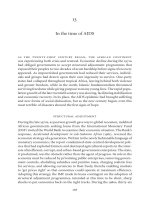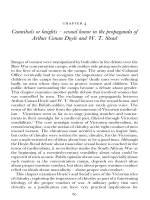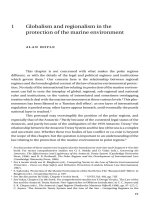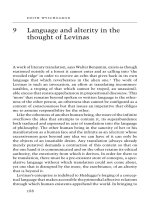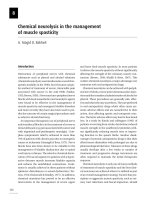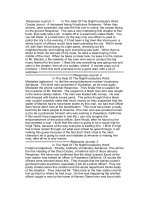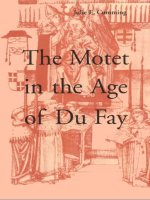krenek e. tonal counterpoint in the style of eighteenth century
Bạn đang xem bản rút gọn của tài liệu. Xem và tải ngay bản đầy đủ của tài liệu tại đây (2.41 MB, 50 trang )
TONAL
COUNTERPOINT
IN
THE
STYLE
OF
THE
EIGHTEENTH
CENTURY
Outline
by
Ernst
Krenek
$1.50
BOOSEY
and
HAWKES
CONTENTS
PAGE
1.
Vocabulary
1
2.
Rhythm
2
3.
Meter
2
4.
Melody
6
5.
Two-part
Counterpoint
16
6.
Three-part
Counterpoint
. 41
Copyright
1958
by Boosey
&
Hawkes
Inc.
Copyright
for all
countries.
All
rights
reseived.
Printed
in U.S.A.
B H.
Bk.
398
Preface
The
purpose
of
this
manual
is
to
present
the
subject
matter
in con-
centrated
form for
the
use of
teachers
and
students who can
devote
only
a
limited
amount
of time
to the
study
of
tonal
counterpoint
Reference
to
the
eighteenth
century
implies
a
limitation in
that
we shall
not
try
to cover all
phases
of
contrapuntal
practice
which
were
developed
during
the
three
hundred
years
of the
reign
of
tonality.
The student
will be
made
acquainted
with a
style
corresponding
to
that of
the
period
in
which
the
older
techniques
of
counterpoint
were
integrated
with
the
modern
idiom
of
tonality,
a
process
which
found its
consummation in
the
works of* J.
S-
Bach.
By
the
same
token
reference
to
the
eighteenth
century
implies
a
generali-
zation,
as
the
technical
instructions of
this
text do not aim
at
a
faithful
replica
of
Bach's
personal
style.
This
would
require painstaking analysis
of
innumerable
details,
not
only
far
beyond
the
scope
of
this
study,
but
also
of
little
value to
a
student
who is
expected
to
acquire
in
a short
period
of
time
a
working knowledge
of a
certain
compositional
practice.
For
this
reason
we have refrained
from
quoting examples
from
Bach's
works.
Such
examples,
obviously
not
written to
demonstrate technical
pro-
cedure,
would
nearly
always
contain a
number of
details which
had
to
remain
unexplained
for the
time
being
and
thus
would
tend
to
confuse the
student.
Our
own
examples
are
designed
to focus the
student's
attention on
the
point
under
discussion and to illustrate it
as
succinctly
as
possible.
After
having
covered
this
material,
teacher
and
student will have no
difficulty
in
finding
analogies
in the literature.
This outline discusses actual
compositional
procedure
as
far
as the
writing
of brief
two-part
and
three-part
inventions
requires
it,
including
the
applica-
tion
of
double
counterpoint
and canonic
devices.
Although
the
fugue
does
not
demand
a
contrapuntal
technique
essentially
different from
that ex-
plained
on
the
following pages,
it
is not
dealt
with
in this
manual,
since
writing
fugues
involves
considerations
of
structure
which transcend
the limits
of this
study.
Assignments
which
summarize
the
consecutive
phases
of the
subject
are
indicated
at the end
of the
relevant
sections
of the text.
The student
may
find
it
useful to
practice
technical
details
(according
to
need and
available
time)
by
writing,
in addition
to the
larger
assignments,
short exercises
con-
cerning
such
details,
as he
goes
along.
Los ANGELES
NOVEMBER
1953
Introductory
Remarks
The
music
to
which the student
is
introduced
in
this
outline
is
essentially
conceived for
instruments,
mainly
such
as
violin,
violoncello, flute,
organ
or
piano.
(While
eighteenth
century
keyboard
music
was
written
for instruments
different
from
the
modern
piano,
we
have become
used to
disregarding
this fact
and
find
it
perfectly
satisfactory
to
perform
that music
on
the
piano.)
Even
the
vocal music
of the era
of
Bach
is
evidently
permeated
by
the
peculiarities
of the
instrumental
style
of
the
period.
The
flexibility
of the
instruments
provides
an
inexhaustible
wealth
of
melodic
and
rhythmic
motions,
and it is
these
which
are
mainly responsible
for
shadings
of
mood and
expression.
While
the
music
is
soulful
and
sensitive,
the emotional exuber-
ance and dramatic
intensity,
so
familiar in
the romantic
music
ol
the nineteenth
century,
are
absent.
Consequently
extreme
contrasts
in
tempo, range
and
dynamics
are
rarely
found.
The art of
counterpoint
consists in
regulating
the
intervals
generated
at
any
given point
by
the
simultaneous
progress
of
two
or
more
melodic lines
according
to
some
principle
set
up
beforehand and
recognized
as
aesthetically
satisfactory.
These
principles
have
varied
throughout
the
history
of
music,
ever
since
the idea of
polyphony
was
introduced
into
the
art
music
of
Western
civilization. The
principle
governing
eighteenth
cen-
tury counterpoint
is
tonal
harmony,
in the sense
that
the
sound-
combinations
arising
among
the
simultaneous
melodies are ex-
pected
to
correspond
to the rules established
in
regard
to
chord
progressions
in
the
realm
of
tonality.
Basic
knowledge
of these
rules is a
prerequisite
for
using
the
present
manual.
TONAL
COUNTERPOINT
IN
THE
STYLE OF
THE
EIGHTEENTH CENTURY
1.
VOCABULARY
The
vocabulary
is
the
major
and
minor
modes and their
transpositions
to all
degrees
of
the chromatic scale.
Chromatic
alterations
of all
tones
of
the diatonic
scale
are available.
Their
use will be discussed
in later
sections
of this
manual.
In
ascending
stepwise
approach
to the tonic and
in
.descending
stepwise
de-
parture
from the tonic the minor scale is
usually employed
in
the
form
known
as
"melodic minor"
(with
a
raised
sixth
degree
in
ascending
motion and a lower
leading
tone
in
descending
motion)
,
in order to avoid the melodic
interval of the
augmented
second.
Example
1
A
Major
Minor
(harmonic)
Minor
(melodic)
* o
How
to avoid
clashes
and cross-relations
between
the
divergently
altered tones
of
the
melodic
minor
scale,
will be discussed
in
the
section
on
two-part
counter-
point.
2.
RHYTHM
(Time
relationships)
The
following
basic
rhythmic
values
are
available:
Example
2
r
rt
(Thirty-seconds
should
be used
only
sparingly
in
very
slow
tempo.)
Any
basic
rhythmic
value
comprises
two values of
the
next
smaller
category
and
may
be subdivided
into
two
of
these smaller values.
A
rhythmic
value to be subdivided
into
three of the
next
smaller
category
is
indicated
by
adding
a dot to the
respective
basic value. The
dot
augments
the
rhythmic
value
by 50%
of its duration.
Example
3
Subdivision
r-
f r
r
r
r
-
iO
The dot
may
also be
used,
with
the
same
function,
in
contexts
based
on sub-
division of
basic values
into
two
smaller
ones. In such
cases
the
dot
indicates
that the
basic
value
is extended
so
as to include the first of
the two smaller
values
which make
up
the
next basic
unit:
r
r-flv
The subdivision into
three
smaller
values
of
a
non-dotted
note
or
any
other
:
rregular
subdivision,
is not
available,
(e.g.,
triplet)
3.
METER
(Accent
conditions)
The music under consideration
is
based
on,
regularly
recurring
accent
patterns,
i.e.,
permanent
repetition
of
groups
of
accented and
unaccented
beats. These
groups
are
known as
bars
or
measures.
Arrangements
and
subdivisions
of
the basic and
augmented rhythmic
values
are
available
in
the metric
schemes shown
in
example
4.
I
9
^^_*%_*%J
Qi_
V
JS
5
*n*
>_^o
'S
"1
:%_*%J
0&00
COM
co^
^-M
cooo
1
I
1
3
I
I
I
1
1
2. RHYTHM
(Time
relationships)
The
following
basic
rhythmic
values
are
available:
Example
2
r
rt
(Thirty-seconds
should
be
used
only sparingly
in
very
slow
tempo.)
Any
basic
rhythmic
value
comprises
two
values of the
next
smaller
category
and
may
be
subdivided
into
two
of these
smaller
values.
A
rhythmic
value
to
be
subdivided
into three
of
the
next
smaller
category
is
indicated
by adding
a
dot
to
the
respective
basic
value. The dot
augments
the
rhythmic
value
by
50%
of its
duration.
Example
3
Subdivision
r-
( r
r
r
r
-
lO
The
dot
may
also be
used,
with the same
function,
in
contexts based
on
sub-
division
of
basic values
into
two smaller ones. In
such
cases the dot
indicates
that
the basic
value
is extended
so
as to
include
the
first
of
the
two smaller
values
which
make
up
the
next
basic unit:
The subdivision
into
three
smaller
values
of a
non-dotted
note
or
any
other
'rregular
subdivision,
is
not
available.
(e.g.,
triplet)
3.
METER
(Accent
conditions)
The
music
under
consideration
is
based
on
regularly
recurring
accent
patterns,
i.e.,
permanent
repetition
of
groups
of
accented
and
unaccented
beats.
These
groups
are
known
as
bars
or
measures.
Arrangements
and
subdivisions of
the
basic
and
augmented
rhythmic
values
are
available
in
the
metric
schemes
shown
in
example
4.
^ "1
:>*-^*J
:*_^*J
-I
^
^1
tl^
3sj
*"
^
*O
5
ss_*%Till
WQO
d
[^
^^
^00
I
i
%-^%_xiJ
3i_^
V
.
>^
^_^%_^%J^
D^v^_
^QD
Dl-^t
*fc_*
CO<W
^
?I]^
}*__
DV
5^-
D%
>-%
D%
^%.
CO^
WOO
1
1
!
i
1
D%_K%J
ft!*!
I
i ill
1
II 111
I
s
It
will
be
noticed
that
progressive
subdivision
creates
secondary
accents
on
beats
which
on
a
higher
level
of
subdivision
remain unaccented.
For
practical
purposes
there
is no
essential
difference
between
6/4
and
6/8;
3/2,
3/4
and
3/8;
2/2
and
2/4;
4/4
and
4/8.
Choosing
one or the
other
of
these
metric
schemes
depends
mainly
on character
and
mood
of
the
music,
according
to
tradi-
tions
established
in
the
literature.
For
information
on
these consult
especially
Bach's
"Well-tempered
Clavier".
Ties
are
used
to
create
rhythmic
values
of
duration different from
those
of
the
basic
or dotted
rhythmic
values.
Ties
are
always
used
when
a tone
is held
across a
barline :
Example
5
Tr
or
r
r
rTfr
or
r
r rT>
9
ete-
Ties
are also
usually employed
when a tone is
held
over
from
one
unit
of
the
metric subdivision
into
the
next
unit
within the same
bar,
even
if
the
duration
of
such a
tone
could be
expressed
by
a basic
or
dotted
rhythmic
value.
Example
6
Subdivision
units
!
I
f
s
V
I
In
duple
and
quadruple
time the
following
is
acceptable:
Example
7
I
r
?
r
r
rr
r
M
instead
of
I
r
r
pr
r
rcrr
Holding
over
a
tone
into
the
following
accented
beat
eliminates
the
articulation
of
that
beat.
This
procedure
should
be
used
occasionally
to
enhance
liveliness and
elasticity
of
the
melodic
line,
since
constant
articulation
of
all
accented
beats
tends
to
make it
sound
wooden and
mechanical.
Example
8
<fo*B J
J
J
l
J
I
r
J
_,
,
'
B
r r
_j
^_,
!
,_,
p.
nijr.1
'
ii
r
r
A it
_ .
r r
recommended notation:
r
Tying
over
from
an unaccented beat
to
an
accented
one
is called
syncopation.
[ts characteristic
feature is that
the
actually
sounded
beats, though
unaccented,
receive
emphasis
so
that the accents
appear
to be
displaced
from
those beats
which,
if
sounded,
would
carry
accents
in the chosen metric
scheme.
Example
9
^.
'^'
=F=
t
F
Syncopation
persisting through
a series
of consecutive
beats
is not
recom-
mended
in
unaccompanied
melodies as it
tends
to
obscure the
metric
scheme.
Example
10
Syncopation
It
may
be used
to
advantage
in
polyphonic
settings
(see
section
on
two-part
counterpoint)
.
4. MELODY
The discussion
of
the
following
section
is
devoted
to
the
study
of
single-voiced
melodies,
without
counter-
point
or
accompaniment
A. INTERACTION
OF
PITCH CHANGE
AND
RHYTHMIC
MOTION
The melodies
which
make
up
the fabric
of
polyphony
may
be understood
as
manifestations
of
a
stream
of
energy
the
fluctuations
of
which are made
perceptible
in the
tones
through
which
the
melodic
lines
proceed
Upward
motion
indicates
increase
of
energy,
downward
motion
the
opposite
Skips
indicate sudden
changes
of
energy
(the
larger
the
skip,
the
more
drastic
the
change),
stepwise
motion
indicates
gradual
changes
The
fluctuations
of
energy
indicated
by
the
motion of
the melodic line
through
various
pitches
are
reflected
in the
rhythmic
organization
of
the
melody,
i
e.,
in
the
relative
duration
of its
tones.
Small
rhythmic
values
(short
tones)
condense
the
changes
of
pitch
into
short time
spans
and
indicate
lapid
fluctuations of
energy,
long
rhythmic
values
indicate the
opposite.
Example
11
Example
11
shows
a
melodic
line
beginning
with
a
manifestation
of
great
energy
(octave
skip
up)
which is
very gradually
released
(scalewise
motion
down)
without
rhythmic
articulation.
Example
12
In
Example
12
the
release
of
energy
takes 17
times as much
time as
the
build-
up
(8
quarter
notes vs.
1
eighth
note)
.
Example
13
j
r
In
Example
13
the
release
takes the
same
amount of
time
as
the
build-up.
The
build-up
is
sudden,
but
relatively
slow
(2
quarter
notes),
while
the
release
is
gradual,
but
fast
(6
sixteenth
notes)
The
equality
of
the
time
spans
causes
the
configuration
to
produce
a
quasi-symmetrical
correspondence
of
opposing
elements
Because of
this
multiple
balance
Example
13
comes
so far
closest
to
the
aesthetic
concepts
underlying
eighteenth
century
polyphony.
Since
complete
canceling
out
each
other of
energy
created
and
expended
is
ideally
seen
as
the
net
result
of
any
musical
process,
a
situation
in
which
the
energy
level
is zero
must
not
be
reached
before
the
melody
is
meant to
come
to
its
end.
In
this
respect
Examples
11
to
13
would
be
satisfactory
only
if no
continu-
ation
of
these
melodies
were
contemplated.
a)
Example
14
Example
14
shows
three
variants of
the
same
basic
melodic
design.
In 14
a)
the
rhythmic
detail
is
a
little
more
complex
through
introducing
dotted
quarter
notes
in
the first
bar,
dotted
eighth
notes
in
the
second
In 14
b) the
upward
skip
of
an
octave
is broken
through
interpolation
of
tones
(E,
G),
and
similarly
the
downwaid
motion
is
briefly
interrupted
when
it
reaches
F.
14
c)
shows a
slightly
elaborated
and
extended
version
of the
design
of 14
b).
Examples
15 to 17
demonstrate
other
types
of
melodic
design
as a
result of
combining
the elements studied
so
far
Example
15
In
Example
15
the
energy
manifest in
the
ascent
of the
first
five
notes is
con-
densed
by
leturning
once
more to
A
(last
eighth
of the
first
bar)
and used
to
reach
a
still
higher
level
F in
one
straight
skip
This drastic
build-up
is
re-
leased over
a
span
of two
bars,
first
by
dropping
below the level
of
the
beginning
down
to
G
sharp,
then
swinging
back to
this
level
by
returning
to
A
with an
exact
retrogression
of the first
five notes.
Example
16
Example
16 shows the
opposite
of
the
design
of
Example
13 The
energy
lost
in the
downward
skip
of an octave
is
gradually
recovered
in two
ascending
moves.
While
the
first of
these
covers the
interval of
a sixth
(from
F to
D),
the
second
spans
a
seventh
(G
to
F).
The
larger
amount of
energy
needed
for this
greater
effort
is
symbolized
in
the
accumulation
of smaller
rhythmic
values
(sixteenth
notes)
in
the
second ascent.
Example
17
Example
17
being
slow and of a
lyrical
nature,
the melodic
energy
fluctuates
within
narrower
limits and
consequently
the
manifestations
of
these
changes
are
less
drastic
then in
the
previous examples
The
idea
of
the
design
consists
in
compensating
gradually
for
the
drop
of
the
pitch
level
from
D
to
E
by
regaining
the
higher
level
in
a
series
of
gently
undulating
moves
The ascent
covers
exactly
twice
as much time
as
the
drop
(
10
quarter
beats
vs
5
)
According
to
the
mood
of
this
melody
the
ascending
motion
represents
reposefully
settling
on
the
original
level,
not
recapturing
it with
a
conquering
gesture,
as was the
case in
Example
16.
Consequently
the
ascending
motion
of
Example
17
slows
down
toward
the
end
(longer
rhythmic
values),
which
is the
opposite
of
what
happened
in
Example
16.
B.
HARMONIC
BACKGROUND
In non-tonal
idioms
(such
as
the
modal idiom
of
the
Middle
Ages
or
the
contemporary
atonal
one)
the articulation of
any
single
melodic
line
mainly
rests
upon
the elements discussed so far
(changes
of
pitch,
length
of
tones
and,
to
.some
extent,
distribution
of
accents)
In
the tonal
idiom
as
a
most
important
factor
is
added
the harmonic
background
which
is
implied
in
the
melodic
line,
even
if
this
line
is
sounded alone It
becomes
manifest
in
the
selection
of
tones of
which
the
melody
consists
and
through
their location
in
the
rhythmic
and
metric
design
The
sequence
of
chords
implied
in
the
progress
of
the
melodic
line
is
regulated
by
the
principles
of tonal
harmony
The
harmonic
background
of
the
melodies
discussed in
this
section
consists of
diatonic
chords
only
(triads
and
seventh
chords
build
upon
the
degrees
of
the
scale
of
the chosen
key
and
utilizing
only
the
tones
of that
scale)
.
In
the
following
examples
the chords
implied
in
the
melodies
are
indicated
by
the
conventional
symbols
(large
Roman
numerals for
major
chords,
small
Roman
numerals
for
minor,
etc
)
Since
the melodies
discussed
here
are
meant
to
be
played
without
additional
voices
or
accompaniment,
it is
not
necessary
to
think
of the
harmonic
background
in
terms
of
an
elaborate
and
consistent
harmoni-
zation
Nonetheless
the
implied
chords must
be
clearly
visualized
and
be
repre-
sented
in
the
melody
through
their
characteristic
tones At
least
some
of
these
tones should
be
placed
on
accented
parts
of the
metric
scheme
because
it is
there
that
they
will
receive
the
necessary
dynamic
emphasis
The
non-chord
tones
of the
melodic
line
generally
belong
to
the
categories
of
passing
tones,
alternating
tones
or
suspensions
(appoggiaturas)
This
subject
will
be
treated
more
fully
in
the
section on
two-part
counterpoint
In
Example
18
the
implied
chords
are
notated
schematically
in
the
second
staff.
Their
characteristic
tones
as
represented
in
the
melody
are
marked
by
+.
Example
18
=*==
*
The
leading
tone
in
a
final
cadence
will
usually
be
sufficient
to
imply
a
dominant
chord
*
The conventional cadontial
situation
suggests
strongly
the tonic
six-foui chord
although
the
melody
has
no
F
sharp
According
to
the nature
of
tonal
harmony
and
because
of
the
flexibility
of the
melodic
design
the chordal
implications
of
a
melody
may
not
always
be un-
equivocal,
especially
in
more
complex
cases So for
instance the
harmonies
under-
lying
bars 3
and
4
of
Example
18
b)
could
also
be heard as
follows:
Example
19
IV
7
4
This
alternate
version does
not affect the
general
constructive
meaning
of
the
chord
progression
suggested
in
Example
18
In
the
present
section
chromatic
alterations
are
introduced
only
as far
as
such
are
necessary
to
prepare
a half-cadence on the
dominant of
the
major
mode,
or
on
the
relative
major
of the minor
mode,
through
their
own dominant
chords This
means
that
in
the
major
mode
the
fourth
degree
has
to
be raised
in
order
to be-
come
the
leading
tone
of
the
dominant
key,
and
that in the
minor mode the
leading
tone
must be lowered
to
become the
dominant of the
relative
major.
Example
20
vi (niof
D)
Vof
V
V(=IofD)
*
here
the
4th
degree
of
G
is raised
and
equals
the
leading
tone
of
D
^
G
V
\\
1
here
the
leading
tone
of
e
is lowered
and
equals
the 5th
degree
of G
Invention
of
a
melody,
then,
involves
integration
and
blending
of
the
four
elements
discussed
so
far:
change
of
pitch,
and
.
rhythmic
motion,
which
are
essentially
responsible
for
expressing
the
fluctu-
ations
of
energy.
These
must
be
fitted
into
the
preconceived
metric
scheme
(accent
pattern)
,
and
coordinated
with
the
harmonic
background
implied
in
the
melodic
line and
organized
according
to
the
principles
of
tonal
harmony.
C
MELODIC
DESIGN
IN
DETAIL
To
accomplish
this,
the
following
suggestions
should
be
considered:
a)
Skips
should
be
used
mainly
to
outline
the
underlying
chords.
b)
Non-chord
tones
should
appear
mainly
in
stepwise
motion,
as
passing
or
alternating
tones.
c)
Rhythmic
configurations
and
melodic
elements
should
be
combined so
as
to
form
characteristic
small
musical
units
known
as
motifs,
Motivic
design
Motivic
units
established
in
the
beginning
of
the
melody
should be
used
consistently
to
spin
forth
the
design
by
repeating
them
in
varied forms.
The
following
are
sipme
devices of
motivic
variation.
1.
Repetition
at a
different
pitch
level.
If literal
repetition
of
a motivic
unit
takes
place
immediately
after
its
appearance,
on
a
higher
or lower
pitch
level,
the
process
is called
sequence.
This
device
is useful
especially
in
spinning
forth the
design
after
the
initial
statement,
or
in
the
approach
to
cadences.
Example
21
The
sequence
should
not contain
more than
three
statements
of the
motivic
unit.
(For
other
functions
of
the
sequence
see
section
on
two-
part
counterpoint.)
2.
Retaining
the
rhythmic,
altering
the
melodic
shape
of
the
motif.
10
Example
22
3.
Retaining
the
melodic,
altering
the
rhythmic
shape
of
the
motif.
Example
23
4. Inversion
(change
of
direction of the
melodic
motion into
its
opposite,
rhythmic
shapes
being generally
retained
unaltered
)
.
Example
24
mi MII
5.
Contraction,
by
cutting
off,
Example
25
,
j
'
, ,
,
**
cutoff
here
and here
or
cutting
out.
Example
26
Motif
cutout
here
6.
Extension, by adding,
Example
27
Motif
added
or
inserting.
11
Example
28
a)
Motif
inserted
7.
Diminution
(smaller
rhythmic
values)
.
Example
29
a)
Motif
8.
Augmentation
(larger
rhythmic
values).
Example
30
9.
Extracting
smaller elements
from
the
motivic units
and
interlocking
the
design
of the
melody
by
combining
these smaller
elements in
various
ways.
Example
31
d)
The
harmonic
background
should be
so
conceived
that
the
key
is
firmly
established
at
the
beginning
of
the
melody.
Chord
progressions
like
I
-
V,
I-IV-V,
I-vi-V,
I-ii-V,
will
serve the
purpose.
The
chord
scheme
at
12
the end
should
reflect
the
traditional
cadence:
TV
-Ij
-
V-L
ii
6,
ii
7,
IV
7,
or vi
may
be
substituted
for
IV
(in
the
major
mode;
arrangements
in
the minor
mode
are
analogous,)
The
plagal
cadence
(IV
[or
iv]
-I)
may
be used
occasionally.
It
occurs
more
frequently
in
the
minor
mode
and
in
polyphonic
settings.
Syncopation
is
used*
occasionally
in
cadences
in
6/4, 6/8,
3/4,
or
3/8
meter in
order to
produce
the
so-called
hemiola
effect, by
which
a 3/2
or
3/4
unit
is
created
on
the last
six
beats
of
the
basic
meter.
Example
32
e)
Each
phrase
of the
melody
should
reach
its
highest
point
only
once.
f
)
The
melody
should
not fall
apart
into
symmetrical phrase
units.
While such
may
be
appropriate
in
homophonic,
tune-like
settings,
it is at variance
with-tKe
principle
of continuous flow
in
polyphonic
music.
Example
3 3
a)
wrong
s
,
b)
right
e
g)
Interest
may
be
added
to
the
melodic
design
by
splitting
the
melody
so
that
it
suggests
two
separate
strands
proceeding
alternatingly
on
different
pitch
levels. In
such
cases
the
highest
and lowest
tones must show
some
melodic
and
rhythmic
continuity
of their
own,
apart
from
the
continuity
of the
whole. The
harmonic
background
must
of course
apply
to
the total
13
Example
34
split
m
a)
Moderate
Example
3
5
MODELS
jj.
b)
Allegro
J
J
3B^=
d)
Andante
14
g)
Allegro
i
J i
1
1
LL
II f
f
I
E
id
I
Assignment
1
Write several
one-part
melodies
in several
major
and minor
keys,
different
in
mood,
meter
and
speed,
4
to
10
bars
long,
with
the
har-
monic
background
moving
from
I
through
a few diatonic
chords and
returning
to
I,
after the
models
of
Example
35
a)
.
Assignment
2
Write
several
one-part
melodies
as
above,
with
the
harmonic
back-
ground
moving
a)
in
the
major
keys
from
I
through
several
chords
to a
half-cadence
on
V,
introduced
by
the
dominant
of
V;
b)
in the
minor
keys
from
I
through
several
chords to
the relative
major
key,
introduced
by
its
dominant,
after
the
models
of
Examples
35
b)
and
15
5.
TWO-PART COUNTERPOINT
A.
INTERVALS
Intervals
are classified
as consonances
and dissonances.
Consonances:
unison
minor and
major
thirds
perfect
fifth
minor and
major
sixths
octave
minor
and
major
tenths
perfect
twelfth,
etc.
Dissonances:
all
the
rest.
While consonances are
acceptable
unconditionally
anywhere
in
the
musical
process,
the
use
of dissonances
is
subject
to
special
consideration
in
relation
to
the accent
pattern
and
the
harmonic
background.
Dissonances
may appear
on
1)
unaccented,
and
2)
accented
beats.
1.
Dissonances
on
unaccented
beats are
basically
passing
tones
(moving
stepwise
in
the
same
direction
from
one
consonance
to
another)
Example
36
x
=
passing
tones
or
alternating
tones
(moving
stepwise
up
or
down
from
a
consonance and
returning
to
the
same
tone)
.
Example
37
alternating
tonee
16
Variants:
a)
Relatively
accented
passing
tones.
The
dissonances
appear
on
beats
carrying
secondary
accents.
Example
38
x
=
passing
tones
b)
The
consonant tone
which
should
follow
the
passing
tone
is
delayed,
being
preceded by
its
next
higher,
or
next
lower,
or
some
other
tone.
Example
39
x
=
passing
tone
c)
Alternating
tones not
returning
to their
basic tone.
Example
40
x
=
Alternating
tones
2.
Dissonances
on accented beats
are
basically
suspensions,
i.e. the dissonant
tone
is
held over from the
preceding
beat,
on which it
is
consonant,
and resolved
stepwise
down
on
the
following
unaccented
beat.
Example
41
Preparation-
Dissonance
-Resolution
D-R
-D-R
17
Variants*
a)
The
resolution
occurs
later
than
on
the
unaccented
beat
immediately
fol-
lowing
the
dissonance.
Example
42
b)
The
dissonance
is
not
prepared
by
being
held
over
from
the
preceding
beat
(appoggiatura).
Example
43
x =
appoggiaturas
c)
The
resolution
is
delayed
by
interpolating
one
or more tones
(or
rests)
between
the
dissonance
and
its
resolution.
Example
44
18
R
m
d)
The
dissonance
is
resolved
upward
instead of
down. This occurs more
frequently
when
the
upward
resolution
requires
a
half-step
(most
fre-
quently
when
the
leading
tone
forms
the
dissonance)
.
Occasionally
a
whole-
step
up
may
also
serve to
resolve
the
dissonance.
Example
45
e) Anticipated
resolution:
the
resolution
is
sounded
before the accented
beat
on which
it is
expected
to enter.
Example
46
x
=
anticipated
resolution
f)
The dissonance
is created
through
anticipation
of
one
or
more
of the
characteristic
tones
of the
chord
subsequently
suggested
by
the
harmonic
background.
Example
47
c
anticipated
from
iofthenextto
next
bar
The
variants
explained
above
may
in some
cases be
appropriately
combined
with
one another.
19
